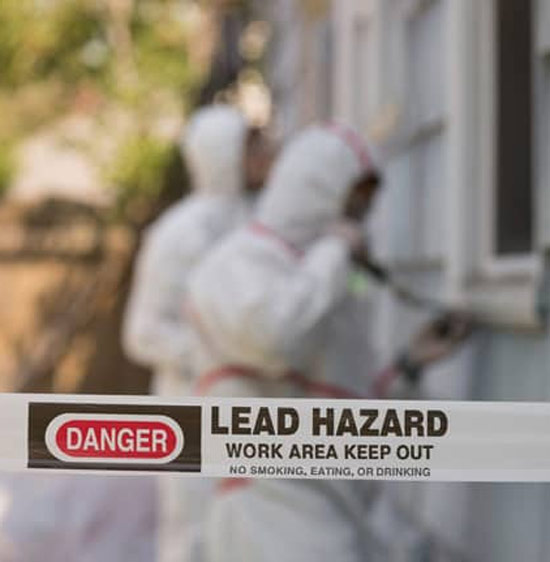DOH & HPD Lead Violation Removal NYC-- Professional Providers for Compliance
DOH & HPD Lead Violation Removal NYC-- Professional Providers for Compliance
Blog Article
Step-by-Step Process for Effective Lead Infraction Remediation
Following this, adherence to federal and state regulations is critical to developing an effective removal plan. The real remediation calls for skilled personnel to carry out these plans while strictly following safety and security methods. What happens after the removal is completed?

Discovery and Evaluation
Discovery and assessment are vital action in the remediation of lead infractions. To ensure an efficient remediation process, it is important to conduct an extensive evaluation of the setting where potential lead direct exposure exists. The preliminary stage of discovery includes identifying sources of lead contamination, which can be found in paint, water pipes, soil, and dirt. Making use of innovative diagnostic devices such as X-ray fluorescence (XRF) analyzers and atomic absorption spectroscopy (AAS) can supply exact measurements of lead focus.
This consists of assessing the extent and intensity of contamination, as well as recognizing populaces at risk, specifically kids and expectant ladies. The collected information need to be carefully recorded to support the advancement of an efficient removal method.
Additionally, it is necessary to focus on locations with the highest degree of contamination and those that pose the best wellness threats. Reliable interaction with stakeholders, consisting of property proprietors, locals, and public health and wellness officials, is crucial for making certain that all parties are informed regarding the searchings for and the subsequent actions needed for removal. This preliminary discovery and assessment stage prepares for an effective lead infraction removal process.

Lawful and Governing Compliance
Browsing the landscape of legal and governing conformity is a critical facet of successful lead infraction remediation. Conformity makes sure not only the security of affected populaces however likewise the credibility and lawful standing of the organization in charge of remediation. Regulations controling lead contamination are diverse, incorporating federal, state, and neighborhood laws. At the federal level, the Environmental Security Agency (EPA) sets rigorous requirements under the Poisonous Compounds Control Act (TSCA) and the Lead-Based Paint Renovation, Fixing, and Painting Policy (RRP Rule)
This includes careful paperwork of all remediation tasks to demonstrate conformity. Failure to adhere to these regulations can result in severe fines, including large penalties, lawful activity, and reputational damage.
Involving lawful experts concentrated on ecological regulation can promote browsing these intricacies. Regular training and certification for all personnel associated with the removal procedure are also required to guarantee adherence to safety and security and governing criteria. By prioritizing lawful and regulatory conformity, companies can effectively mitigate threats and attain a successful remediation end result.
Planning the Removal
Successfully intending the remediation of lead offenses starts with a thorough assessment of the contaminated site. This data-driven strategy makes certain that remediation efforts are appropriately targeted and reliable.
As soon as the contamination is mapped, a threat evaluation need to be conducted to examine over here potential health and wellness dangers to people and the setting. Lead Violation Removal in NYC. This assessment must think about elements such as exposure paths, population vulnerability, and environmental influences. The understandings collected will develop the basis for selecting an appropriate remediation technique
Ultimately, setting clear, achievable goals for the removal task is vital. These purposes must align with regulative standards and stakeholder expectations to make sure compliance and neighborhood acceptance. Developing an in-depth removal plan that describes approaches, timelines, and source appropriation will certainly assist in a structured method to the clean-up procedure.
Furthermore, it is important to engage with stakeholders early and keep transparent interaction throughout the planning phase. This consists of informing neighborhood areas, acquiring needed licenses, and collaborating with regulative firms to guarantee all lawful and procedural requirements are fulfilled. A well-crafted remediation plan not only deals with the contamination properly however also builds count on and collaboration amongst all events included.
Performing the Removal
With a well-structured remediation plan in location, the focus moves to the real execution of the remediation activities. This stage involves activating the necessary sources, consisting of skilled workers, specific devices, and top quality materials. Begin by plainly marking duties and obligations to ensure responsibility and smooth control among group members.
This consists of establishing up control locations to protect against lead dust and debris from spreading, Learn More as well as employing air purification systems to preserve air high quality. Utilize techniques such as wet scratching, chemical removing, or encapsulation, depending on the severity and location of the contamination.
Throughout the remediation procedure, conduct routine examinations and air quality keeping track of to make sure conformity with governing requirements. Efficient interaction with stakeholders, consisting of property owners and occupants, is important to keep them notified of progression and any kind of unanticipated growths. By diligently adhering to these actions, the remediation activities can be carried out successfully and efficiently, eventually mitigating lead dangers.
Post-Remediation Strategies
Post-remediation methods play an essential duty in making sure the long-lasting success of lead violation remediation efforts. These techniques encompass ongoing monitoring, upkeep, and neighborhood education to prevent future lead exposure and make certain a risk-free atmosphere.
First, regular surveillance is necessary. This involves routine testing of the previously influenced areas to ensure that lead degrees stay within risk-free limits. Property proprietors ought to develop a routine for these tests, preferably in collaboration with certified ecological experts.

Third, informing the area plays a critical duty in maintaining the benefits of remediation. Citizens and property managers must be educated concerning the risks of lead direct exposure and the very best practices for maintaining a lead-safe setting. Workshops, informational handouts, and community conferences can be effective tools for sharing this info.
Verdict
Effective lead violation remediation requires a comprehensive, systematic approach including detection and evaluation of contamination, adherence to legal and regulative requirements, careful planning, and efficient implementation of remediation efforts. This methodical process underscores the significance of thoroughness and vigilance in addressing and mitigating lead contamination.
Report this page